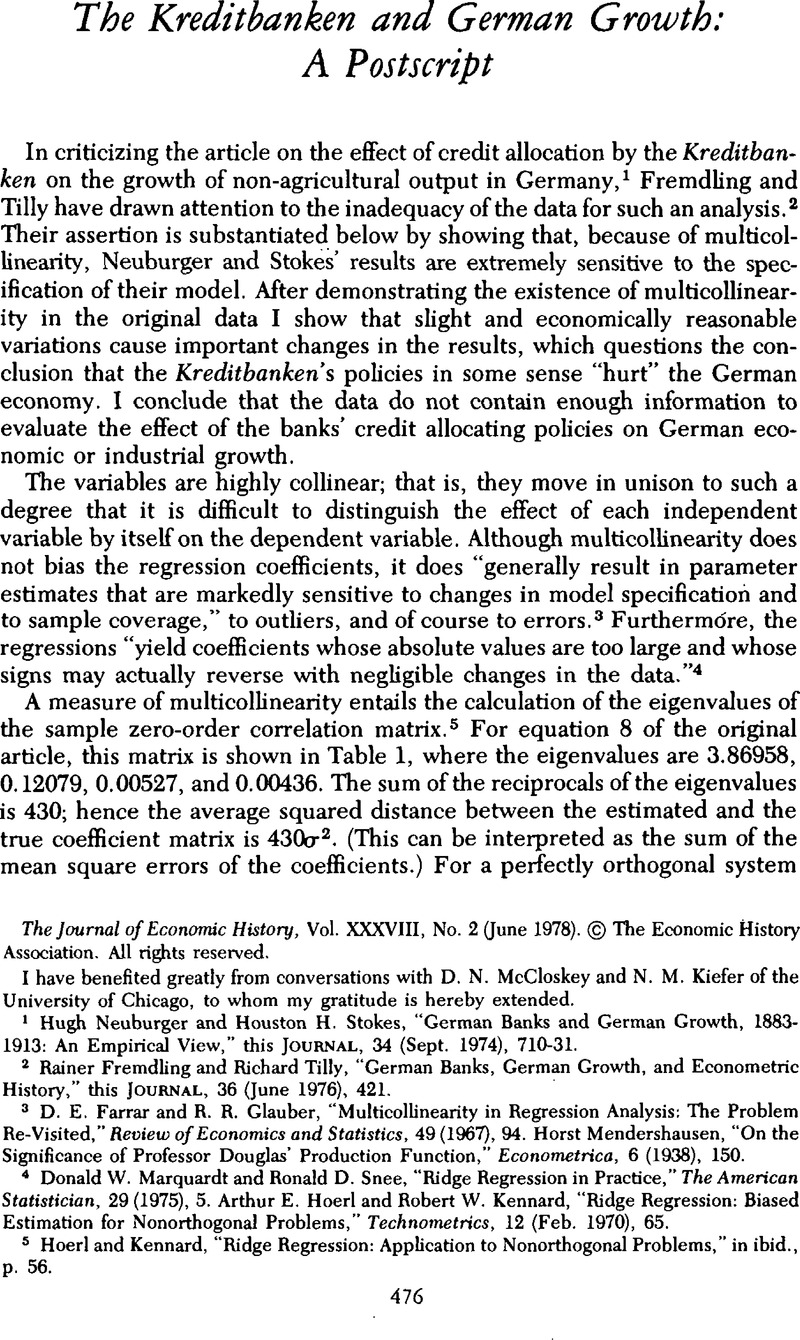Published online by Cambridge University Press: 11 May 2010

1 Neuburger, Hugh and Stokes, Houston H., “German Banks and German Growth, 1883–1913: An Empirical View,” this Journal, 34 (Sept. 1974), 710–31Google Scholar.
2 Fremdling, Rainer and Tilly, Richard, “German Banks, German Growth, and Econometric History,” this Journal, 36 (June 1976), 421Google Scholar.
3 Farrar, D. E. and Glauber, R. R., “Multicollinearity in Regression Analysis: The Problem Re-Visited,” Review of Economics and Statistics, 49 (1967), 94Google Scholar. Mendershausen, Horst, “On the Significance of Professor Douglas' Production Function,” Econometrica, 6 (1938), 150CrossRefGoogle Scholar.
4 Marquardt, Donald W. and Snee, Ronald D., “Ridge Regression in Practice,” The American Statistician, 29 (1975), 5Google Scholar. Hoerl, Arthur E. and Kennard, Robert W., “Ridge Regression: Biased Estimation for Nonorthogonal Problems,” Technometrics, 12 (Feb. 1970), 65Google Scholar.
5 Hoerl and Kennard, “Ridge Regression: Application to Nonorthogonal Problems,” in ibid., p. 56.
6 I am indebted to Mr. Kiefer for this suggestion.
7 Second order generalized least squares was used. Heteroscedasticity was not indicated. The regression was also run with N = 31 without changing the above results. Note that the hypothesis that the coefficients of In UN and of In K are the same cannot be rejected because one is close to zero and the other is statistically not different from zero.
8 First order generalized least squares was used in this regression. Heteroscedasticity was not indicated. The insignificant coefficient of the capital stock in this and in the previous two regressions confirms previous notions of the tentative nature of Hoffmann's capital stock estimates. Hoffmann himself referred to his capital stock series as a “crude estimate. ” Gahlen, B., Die Überprüfung produktionstheoretisher Hypothesen für Deutschland (1850–11913) (Tübingen, 1968), pp. v, viiGoogle Scholar; as cited by Fremdling and Tilly, “German Banks and German Growth,” p. 422. Richard Tilly has argued elsewhere that this series is not to be taken seriously since the industrial capital stock of the Kingdom of Baden was “extrapolated to cover Germany as a whole by means of a coefficient based on Baden's share (3.8 percent!) of total industrial and handicraft employment.” Tilly, Richard, “Soil und Haben: Recent German Economic History and the Problem of Economic Development,” this Journal, 29 (June 1969), 313Google Scholar.
9 Neuburger and Stokes, “German Banks and German Growth,” pp. 714, 720.
10 On the other hand, they quite properly suggest that the use of data on heavy industry alone would have been improper. Ibid., p. 720.
11 First order generalized least squares was used. Heteroscedasticity was not indicated. An asterisk indicates that the symbols refer to the industrial and handicrafts sector alone. The results were similar without Kuczynski's series and also when the model was extended to include the agricultural sector.